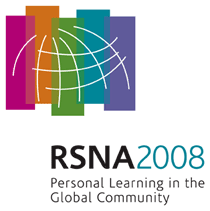
Abstract Archives of the RSNA, 2008
LL-VI4246-H10
Multislice CT Angiography in the Visualization of Fenestrated Endovascular Grafts: Effect of Slice Thickness on 2D and 3D Visualization of the Fenestrated Vessel Stents
Scientific Posters
Presented on December 2, 2008
Presented as part of LL-VI-H: Vascular/Interventional
Zhonghua Sun PhD, Presenter: Nothing to Disclose
Allen Yvonne RT, Abstract Co-Author: Nothing to Disclose
David E. Harley RT, Abstract Co-Author: Nothing to Disclose
Michael MD Lawrence-Brown MBBS, Abstract Co-Author: Nothing to Disclose
The aim of this study was to investigate the effect of multislice CT scanning protocol on the visualization of fenestrated vessel stents in patients with abdominal aortic aneurysms (AAA) treated with fenestrated endovascular grafts..
21 patients with AAA undergoing fenestrated endovascular repair were included in the study. Multislice CT angiography was performed with variable protocols and the section thickness used in each scanning protocol was identified with the aim of studying the relationship between slice thickness and imaging appearance of fenestrated vessel stents visualized on 2D axial, multiplanar reformatted and 3D virtual intravascular endoscopy images. Image quality was assessed based on the degree of artifacts and their effect on the visualization of fenestrated stents.
There were seven different multislice CT scanning protocols in the 21 patients (25 datasets with 4 follow-ups in 4 patients). The slice thickness included 0.5 mm, 0.625 mm, 1.0 mm, 1.25 mm, 2.5 mm, 3.0 mm and 5.0 mm, respectively. Of these CT protocols, images (especially 2D/3D reconstructions) acquired with 2.5 mm, 3.0 mm and 5.0 mm were found to be significantly compromised due to the interference of artifacts. Images acquired with a slice thickness of 1.0 mm or 1.25 mm were scored equally or lower than those acquired with submillimetre section thickness (0.5 mm and 0.625 mm) with minor degree of artifacts resulting in acceptable image quality.
Our results showed that multislice CT scanning protocols with a submillimetre slice thickness are not necessary for evaluation of fenestrated repair of AAA as protocols with a slice thickness of 1.0 mm or 1.25 mm produced similar image quality to those with a section thickness of 0.5 mm or 0.625 mm.
The research findings of this study are valuable for endovascular specialists to choose appropriate multislice CT protocols in the follow-up of fenestrated endovascular repair of AAA.
Sun, Z,
Yvonne, A,
Harley, D,
Lawrence-Brown, M,
Multislice CT Angiography in the Visualization of Fenestrated Endovascular Grafts: Effect of Slice Thickness on 2D and 3D Visualization of the Fenestrated Vessel Stents. Radiological Society of North America 2008 Scientific Assembly and Annual Meeting, February 18 - February 20, 2008 ,Chicago IL.
http://archive.rsna.org/2008/6007711.html

